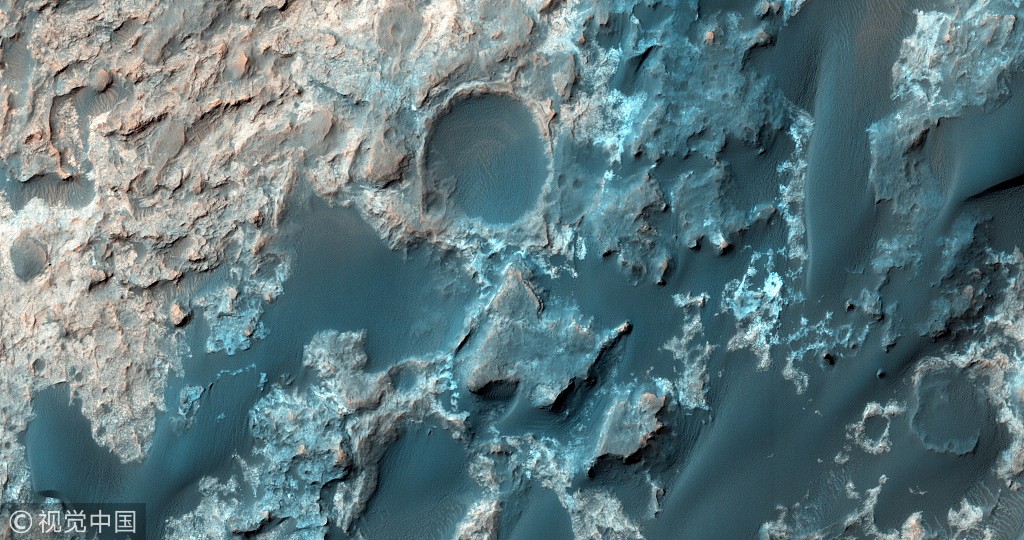Martian immigration? Scholars weigh potential


Editor’s note: Friday night marks Mars Opposition. For observers, the red planet will appear the biggest since its historic position in 2003. Coinciding with this, researchers with the Italian Space Agency announced on Wednesday their discovery of a large reservoir of liquid salt water underneath the polar cap of Mars. Does that promise hope for human immigration to Mars in the future? Two scholars share their comments with China Daily’s Zhang Zhouxiang.
Xu Luyuan, a postdoctoral researcher of planetary geology at Macau University of Science and Technology
Water (H2O) has long been known to exist on Mars, but not in liquid form. In the planet’s two polar regions, there are large quantities of solid water, or ice. Besides that, there are also large amounts of water as ice under the ground. Phoenix, a Mars lander, had dug water ice from the ground in the northern polar region of Mars. More information shows that water ice might even exist in middle-latitude subsurface.
This time, ISA has taken a groundbreaking step by discovering liquid water on Mars for the first time in history, probably. Actually, as early as 1987, the planetary scientist Stephen Clifford had predicted that the highest possibility of water existing on Mars was in the polar regions of the planet, where water hidden deep under ice caps might remain liquid because high pressure lowers its melting point.
However, it is rather difficult to find liquid water under thick ice caps. Currently, one of a powerful technology available on Mars is ground penetrating radar (GPR), which sends electromagnetic waves underground and analyzes the structure based on reflected waves.
This time, Mars Express, the first Mars detection device launched by the European Space Agency, discovered an abnormal region under the ice of the South Polar of Mars with its Mars Advanced Radar for Subsurface and Ionosphere Sounding (short for MARSIS), which is highly likely to be liquid water with a high percentage of salt, such as sodium, magnesium, calcium, and perchlorates.
The importance of the discovery, if confirmed, can never be overestimated because liquid water is the source of life. In the past 20-plus years, space detectors have already found the possible existence of subsurface liquid water Ceres, Jovian satellites Europa and Ganymede, Saturnian satellites Enceladus and Titan, and Pluto.
Of course, by far humankind has not witnessed liquid water on these planets and satellites yet. That’s why some suggest sending more advanced spacecraft, especially more advanced landers and rover to Mars to dig deep into the target regions to confirm the existence of liquid water, and even take the sample back to earth. Some even think about the possibility of mass immigration to Mars in the future.
My proposal is to wait until human technologies are mature enough to both ensure deployment of landers/rovers efficiently and avoid contaminating the environment on Mars with microbes from Earth. In case some contamination happens, the result might be out of our expectation.
The day when we can conveniently travel to Mars will come. But that needs delicate preparations and trials, for decades or even longer.
Sun Zhengfan, a renowned popular science writer
Mars has many things in common with its neighbor Earth. It has an atmosphere (but much more tenuous), white ice caps on the southern and northern polar regions (but not only water ice but also carbon dioxide ice), as well as evidence of the past existence of rivers and even oceans. Its surface rich in iron oxide makes it appear red, which is how it got its name from the god of war.
For a long time, scientists have been extremely interested in the red planet. The European Union and the US have launched many unmanned spacecraft there, while China also has a plan to send its own as early as 2020. With the support of NASA, some US private companies have even been thinking about plans for immigration to Mars.
The key to these plans lies in water resources on Mars. In the past missions, many Mars orbiters and the lander Phoenix had detected the existence of water ice on Mars, while a paper published in Science earlier this year showed that large quantities of water ice are likely to exist in the shallow subsurface of Martian middle latitude regions.
The ISA declared their discovery on Wednesday, but they have been working on that for about six years. And recently scientists analyzed from the 2012 data of MARSIS, a radar device on Mars Express, and found a small but extremely bright zone from the reflection of its sent electromagnetic waves. The past six years of research shows that a salt lake should exist there, 1.5 kilometers underground.
That’s of tremendous meaning to humans, because it makes long-term survival on Mars possible. As our mother Earth faces a declining natural environment, people must especially consider its future, and immigration to outer space would be one available choice. Mars might be the first step in human immigration to the universe. It might take a long time to realize, but at least there is hope.


































